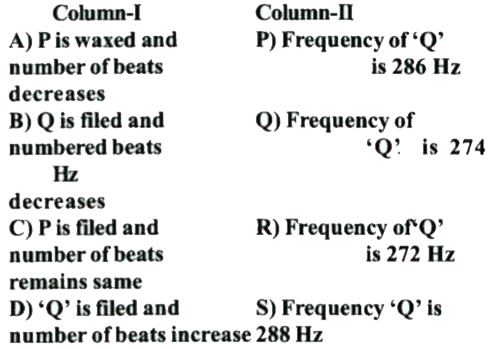(a) A tuning fork produces 4 beats per second with another tuning fork of frequency 256Hz. The first one is now loaded with a little wax and the beat frequency is found to increase to 6 per second. What was the original frequency of the tuning fork ?
(b) A plano wire A vibrates at a fundamental frequncy of 600Hz. A second identical wire B produces 6 betas per second with it, when of the tension in A is slightly increased. Find the ratio of the tension in A to the tension to B.
( c) A tunnig fork if frequency 256Hz produces 4 beats per second with a wire of length 25cm vibrating in its fundamental mode. The beat frequency decreases when the length is slightly shortened. What could be the minimum length by whech the wire be shortened so that it produces no beats with the tuning fork?
The correct Answer is:252 Hz
Initially we use
256−n0=4
because after loading wax on first fork of frequency n0 it reduces so beat frequency will increase thus we use
n0=252Hz
Topper's Solved these Questions
- WAVES BOOK - PHYSICS GALAXY - ASHISH ARORACHAPTER - WAVES EXERCISE - Practice Exercise 6.8
8 Videos
- WAVES BOOK - PHYSICS GALAXY - ASHISH ARORACHAPTER - WAVES EXERCISE - Discussion Question
26 Videos
- WAVES BOOK - PHYSICS GALAXY - ASHISH ARORACHAPTER - WAVES EXERCISE - Practice Exercise 6.6
15 Videos
- WAVE OPTICSBOOK - PHYSICS GALAXY - ASHISH ARORACHAPTER - WAVE OPTICSEXERCISE - Unsolved Numerical Problems
28 Videos
- X-RAYSBOOK - PHYSICS GALAXY - ASHISH ARORACHAPTER - X-RAYSEXERCISE - Unsolved Numerica Problem for Preparation
23 Videos
Similar Questions
A tuning fork produces 4 beats per second with another 68. tuning fork of frequency 256 Hz. The first one is now loaded with a little wax and the beat frequency is found to increase to 6 per second. What was the original frequency of the tuning fork ?
View SolutionA tunnig fork of frequency 256 Hz produces 4 beats per second with a wire of length 25 cm vibrating in its fundamental mode. The beat frequency decreases when the length is slightly shortened. What could be the minimum length by which the wire be shortened so that it produces no beats with the tuning fork ?
View Solution
Knowledge Check
A tuning fork A produces 4 beats/second with another tuning fork of frequency 246 Hz. When the prongs of A are filed a little, the number of beats heard is 6 per second. What is the original frequency of the fork A?
A242 HzB240 HzC250 HzD252 HzA tuning fork A produces 4 beats/sec with another tuning fork B of frequency 320 Hz . On filing the fork A , 4 beats/sec are again heard. The frequency of fork A , after filing is
A324 HzB320 HzC316 HzD314 HzA tuning fork 'P' of frequency 280Hz produces 6 beats/s with unknown tuning fork 'Q'
 AABCDQRSRBABCDQRQPCABCDP.QQ.RR.SPDABCDR.SQ.RSR
AABCDQRSRBABCDQRQPCABCDP.QQ.RR.SPDABCDR.SQ.RSR
A tuning fork of frequency 256HZ produces 4 beats per second with a wire of legth 25cm vibrating in its fundamental mode. The beat frequency decrease when the length is slightly shortened. What could be the minimum length by which the wire be shortened so that it produces no beats with the tuning fork?
View SolutionA tuning fork produces 4 beats per second when sounded togetehr with a fork of frequency 364 Hz. When the first fork is loaded with a little wax ten the number of beats becomes two per second. What is the frequency of the first fork?
View SolutionA tuning fork produces 4 beats per second when sounded togetehr with a fork of frequency 364 Hz. When the first fork is loaded with a little wax then the number of beats becomes two per second. What is the frequency of the first fork?
View SolutionA tuning fork produces 2 beats per second when sounded with another tuning fork of frequency 250 Hz. It gives the same number of beats per second when loaded with wax. The initial frequency of 1st tuning fork is
View SolutionA tuning fork gives 5 beats with another tuning fork of frequency 100 Hz . When the first tuning fork is loaded with wax, then the number of beats remains unchanged, then what will be the frequency of the first tuning fork
View Solution
